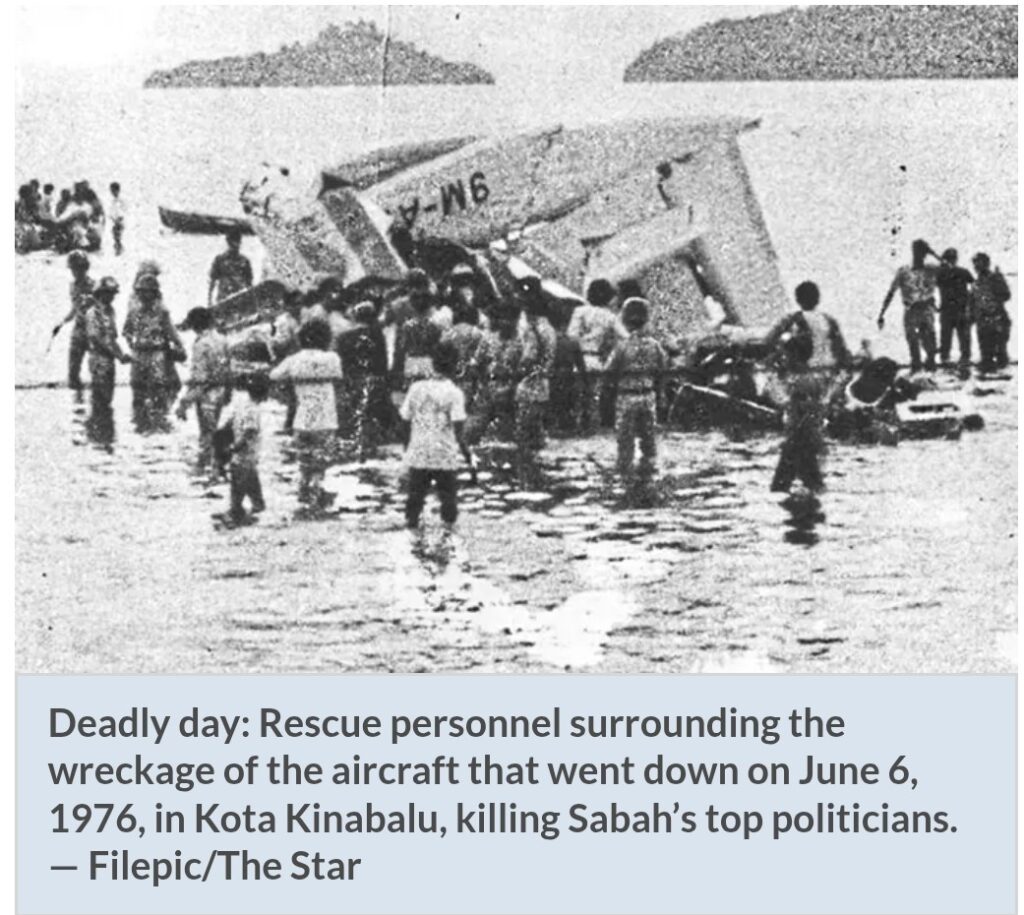By Datuk Philip Golingai
On Friday (June 6), Sabahans commemorated one of the most pivotal moments in their state’s history, which occurred 49 years ago.

The Double Six Tragedy claimed the lives of then Chief Minister, Tun Fuad Stephens, and several key state ministers when the GAF N-22B Nomad aircraft they were on crashed in Sembulan, Kota Kinabalu, on June 6, 1976.
The aircraft, which was flying from Labuan, was approaching Kota Kinabalu International Airport around 3.30pm.
Eye-witnesses in Kampung Sembulan Baru, a village near the crash site, reported that the plane seemed to stall mid-air.
One wing dipped down, and the aircraft entered a spiral, completing one-and-a-half turns.
The Nomad plunged into shallow water, less than 100cm deep, in the South China Sea, off Kam-pung Sembulan.
It broke into two.
All 11 people on board died, including Fuad and top officials of his Berjaya administration, Datuk Peter Mojuntin (Local Government and Housing Minister), Datuk Salleh Sulong (Finance Minister), Chong Thain Vun (Communications and Works Minister), and Darius Binion (assistant to the Chief Minister). The other victims were Datuk Wahid Peter Andu (permanent secretary to the Finance Ministry), Syed Hussein Wafa (director of the Economic Planning Unit), Johari (Fuad’s son), Captain Gandhi Nathan (pilot), Corporal Said Mohammad (Fuad’s bodyguard), and Ishak Atan (Tengku Razaleigh Hamzah’s executive assistant).
The crash happened less than two months after Berjaya defeated Usno in the 1976 Sabah elections and formed the state government.
One of the reasons Fuad and Razaleigh, the then federal Finance Minister and Petronas chairman, were in Labuan was to discuss oil royalties – Fuad was reportedly pushing for more than the 5% eventually agreed upon after the crash.
One of the most popular conspiracy theories about the tragedy is the 5% oil royalties.
If Fuad had survived, according to the theory, Sabah would have secured a more favourable (20%-25%) oil deal, which would have impacted Sabah’s financial resources and development trajectory.
Depending on who you speak to, some will say that before the ill-fated flight, the 5% was already a done deal, while others think otherwise.
The other conspiracy theory is that the aircraft was deliberately tampered with or caused to crash to eliminate those who opposed the 5% deal.
Conspiracy theorists like to use Razaleigh’s account of the crash as proof that sabotage was involved.
A video uploaded at the now defunct razaleigh.com in 2010 showed Razaleigh giving a talk titled “Oil For Who?”, during which Razaleigh told the audience in a community hall in Penampang, near Kota Kinabalu, what happened minutes before the aircraft flew out of Labuan Airport.
“When talking about oil and Sabah, I could not help but remember a sad incident which happened to Sabah and Sabah-ans,” he said, relating the tragic incident involving his good friend Fuad.
“I myself had boarded the plane. … I sat behind Tun Fuad Stephens and on my right was Rahman [Sarawak Chief Minister Tun Abdul Rahman Ya’kub] and behind me was Tengku Bendahara Pahang,” recalled Razaleigh in the video.
“Suddenly, [Tan Sri] Harris Salleh, who was Sabah deputy Chief Minister, asked me to exit the plane as he said it is better we go to Pulau Banggi to see a cattle ranch. I told Rahman Ya’kub and Tengku Bendahara Pahang that it was better if we went to Pulau Banggi as I wanted to see the cattle ranch.”
Razaleigh continued: “The ceremony to sign the agreement to give [Sabah’s] oil rights to Petronas was that night, so I told them we had plenty of time.
“So we flew with Harris in a similar plane.”
On April 12, 2023, following a High Court order, the Malaysian government declassified its findings on the Double Six Tragedy crash.
The report conclusively ruled out any elements of sabotage, fire, or explosion as the cause of the crash.
The primary finding was improper loading and “aft [rearward] centre of gravity position well outside the permissible limits”.
Official finding or not, the conspiracy theorists, who include top Sabah politicians from both sides of the political divide, remain unconvinced. They argue that the finding was a cover-up.
On Friday, one of the conspiracy theory politicians texted me a photograph of himself and other Sabahans at the 49th anniversary commemoration held at the crash site in Sembulan.
In our chat, we discussed the main issues in the coming Sabah polls.
Key among them will be the demand for more than 5% oil royalties, and the evolving Sabah-Federal relationship, which can be characterised by the dynamics between locally-based parties (like PBS, PGRS, Star, Warisan, SAPP, and Usno) versus national parties (such as Umno, PKR, and DAP).
Forty-nine years after the crash, Sabahans are still looking for closure to the tragedy which changed Sabah’s political landscape and its relationship with the Federal Government, particularly regarding the state’s autonomy and natural resources.
Will Sabahans find closure in the ballot boxes later this year?
Editor: This article has appeared in the Star